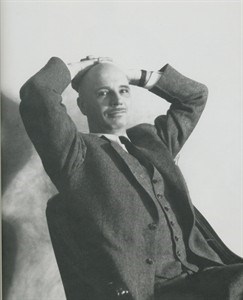
Rockwell Kent, shown in an undated handout photo, an American painter and writer who famously illustrated "Moby Dick," was also a German-speaking rogue who so riled his neighbours in Brigus, N.L., that he was expelled for his own safety. It was 1914, the First World War was underway and many people thought Kent was a spy. THE CANADIAN PRESS/ho-Plattsburgh State Art Museum
June 06, 2014 - 10:44 AM
BRIGUS, N.L. - Rockwell Kent, the American painter and writer who famously illustrated "Moby Dick," was also a German-speaking rogue who so riled his neighbours in Brigus, N.L., that he was expelled for his own safety.
It was 1914, the First World War was underway and many people thought Kent was a spy.
He had visited Dresden in his youth, spoke German and sang lieder — 19th-century German poetic songs — while poking fun at growing suspicions. His open retaliation included a sign posted on his cottage on a seaside cliff just outside Brigus, an hour southwest of St. John's.
It read: "Private. Chart Room. Wireless Station. Bomb Shop." Kent, wearing a painted-on Kaiser moustache, posed for a photo in front of it.
Events this past week and later this summer marking the 100th anniversary of his tumultuous, 17-month stay in Newfoundland have revived interest in a story even many local people don't know.
Caroline Stone, curator of the 2014 Kent Centennial in Newfoundland exhibition at The Rooms provincial art gallery in St. John's, said there's still debate about Kent's ouster.
"Americans feel that he was extradited almost. Newfoundlanders were quoting letters from the period that said he had really just been asked to leave.
"But from what I can understand, he was given the tickets for his family to go back to America, he was given a deadline and he was told that the government couldn't vouch for his safety if he decided to stay."
Kent, his wife Kathleen, and their four young children left in July 1915 to go back to the U.S.
Perhaps no one knows Kent better than filmmaker Frederick Lewis. The Ohio University media arts professor spent more than 10 years off and on tracing the travels that inspired Kent's memoirs and paintings in Greenland, Newfoundland, Alaska, Russia and Ireland.
The result was "Rockwell Kent: A Documentary."
Lewis marvels at Kent's prolific versatility as a writer, artist, architect, carpenter, globe trotter and a thrice-married "major-league philanderer."
"I've done several documentaries on artists and other subjects but Kent is the holy grail and Moby Dick all rolled into one," he said in an interview.
"He seemed to have lived maybe six or seven lives in one."
Kent, a lifelong socialist who denied ever being a member of the Communist party, loudly voiced his views even at his own peril, Lewis said. His legal battle in the 1950s when he was refused a passport on suspicion of being a Communist led to a landmark U.S. Supreme Court ruling. It declared travel a constitutional right that can't be stripped without due process.
In an interview at the time, Kent compared the ordeal to a woman who takes a man's pants to keep him from going out.
"They've stolen my pants in taking my passport. And I want my pants back."
Lewis recounted how Kent first arrived in Newfoundland in 1910 with plans to set up an art school in an empty fish plant in Burin. That fell apart when word came that Kent's extramarital lover was expecting a child in Boston.
He moved to Brigus in February 1914 in search of a place to immerse himself in his painting. His wife, Kathleen, joined him in the spring of that year. They had their fourth child while living in the Brigus house and would have a fifth before divorcing in 1926. Kent would marry, divorce and marry again.
His paintings still hang in galleries ranging from the Metropolitan Museum of Art in New York City to the State Hermitage Museum in St. Petersburg, Russia.
The 200-year-old Brigus house on four protected hectares is now restored as an artist's retreat called the Kent Cottage at Landfall overseen by the Landfall Trust charity.
It is a well-loved gathering place for workshops and events. And it now features a new female figurehead over the main entrance. She is a replica of a protective wooden ship's carving that Kent restored, along with what he called her "bosom of disturbing opulence," and hung over the cottage doorway.
On June 21, Kent's birthday, the Landfall Trust and carver Vince Jones will dedicate the new figurehead.
Stone said with a laugh that she can think of one other fitting tribute.
"She deserves to be called Kathleen."
Follow @suebailey on Twitter.
News from © The Canadian Press, 2014